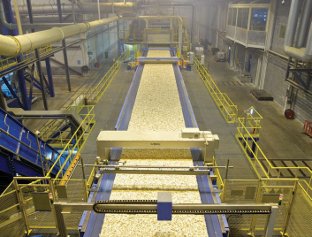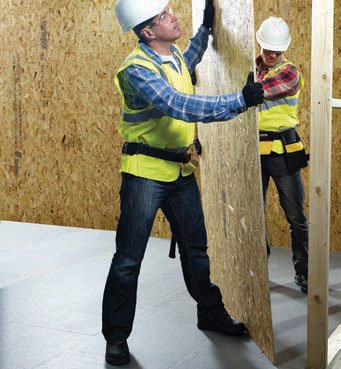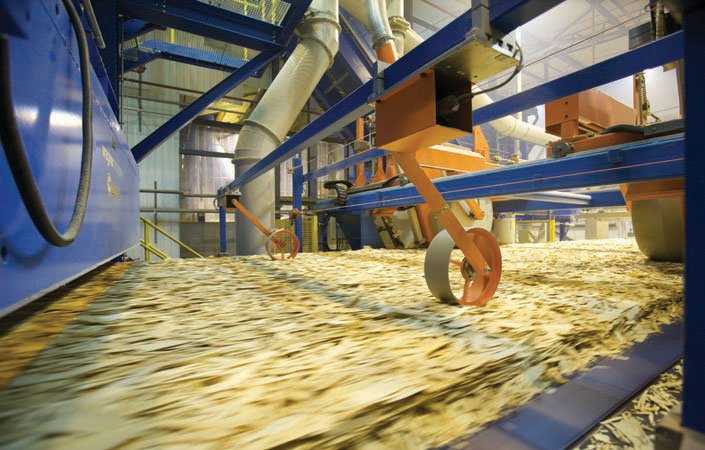OSB is good for the future
17 May 2017Europe in 2016 saw record-breaking production of OSB. Demand continues to increase andnew mills are coming into production. Julian Champkin reports
OSB is the board with the future. Its steady penetration of the plywood market continues, for all kinds of reasons. More flexible source material that is cheaper and more readily available is one – OSB does not rely on the veneers from roundwood logs that plywood needs. Performance is as good or better than plywood; and there is a price advantage to consumers as well. But OSB is carving out uses and markets on its own account quite separately from plywood, notably in furniture, hoardings and packing cases; and it is lending itself to specialised niche variants, such as for roofing and sidings – though this aspect is more in evidence in the US than in Europe. On both sides of the Atlantic, and indeed globally, the market seems limited at present not by demand, but by supply.
As we reported in this feature last year, (see WBPI April/May 2016) European OSB mills were producing to near-capacity in 2015, and were expecting to do the same in 2016. That expectation has been largely fulfilled. Production has hit a record level. The most recent calculations from the European Panel Federation (EPF) show that European production of OSB rose by 3.9% in 2015 to exceed five million m3. We reported last year that new capacity from eastern Europe was impinging on west European producers, and indeed with the commissioning of Kronospan’s Strzelce Opolski plant, Poland expanded its capacity from 400,000m3 in 2014 to 740,000m3 in 2015 and joins Germany and Romania to form the ‘big three’ in OSB.
EPF forecasts for 2016 production figures are 1,270,000m3 for Germany and 1,000,000m3 for Romania, both unchanged from 2015 and expected to remain unchanged through 2017.
Those countries aside, new mills – nearing completion, or recently completed and now producing – are the story in Europe, especially in what we can call "off-shore Europe". Kronospan, Smartply and Norbord are the big names in this part of the story. Kronospan has begun production in Hungary; there is the £95m (€110m, US$135m) investment of Norbord at Inverness in Scotland, due to become operational this autumn; and Smartply’s new mill in Waterford, Republic of Ireland, began production in April 2016.
We shall deal with them each in turn below; but between them these new plants are adding, or will add, nearly 800,000m3 to Europe’s 2016 capacity of five million m3/ year – a mere whisker short of one-sixth. And five million m3 is, as we have seen, already a record.
Production of course is linked to pricing, and OSB pricing has in the past been notoriously volatile. Can that volume of capacity really be added to the European market without a collapse in price? Norbord evidently believes so. “Panel demand in the UK, our largest market, has continued to grow,” says Peter Wijnbergen, Norbord's president and CEO, in the company’s annual report. “Our European business continues to be a stable source of earnings despite the uncertainty created by the Brexit referendum in the UK, and the weaker Pound Sterling is making our domestically-produced OSB … more competitive against imported Asian and South American plywood.” Being the world’s largest OSB producer, Norbord's analyses must carry some weight. It doesn't comment directly on prices; but from what it does say, and from its actions, deductions can be made.
Norbord’s spokesman did give us many pertinent comments. They can be summed up in the phrase: “The growth of OSB continues”. He added and enlarged on this: “There will be times when capacity overtakes consumption. But we believe that when you have market growth of around 14% as we did last year; and that growth is on a market of 650,000m3 annually” – which is the combined capacity of Norbord’s Inverness and Genk (Belgium) mills – “then that translates into an extra demand that equates to a whole new press-line every two or three years.” And that is not dependent on any special efforts to increase consumption. “That is just to satisfy the market’s demand."
“So we are reaching a point when we need more capacity in Europe before we reach boom and bust.”
The quality of much of the plywood imports helps make his case. “70% of Far Eastern plywood is here without proper documentation.”
"There’s been a definite change in the past 18 months to two years."
"Most flat-roof construction is OSB now. The major timber-frame builders, the major flat-roof builders, have switched from plywood to OSB already. The small builder and handyman” – in Britain the so-called ‘white van man,’ - “is beginning to make the change to that as well.” With a price advantage that can be £6-7 a sheet, that is perhaps not surprising.
Europe is not homogenous: national cultures play their part. “Historically, the UK is a plywood country. Unlike Germany and the US, where OSB flooring is ubiquitous, the UK uses particleboard for floors. But OSB is gaining a specialist niche in I-joists and the like. In tests of modular building, OSB is the product of choice – and increasingly is being seen to be such.”
And modular building, he says, has to have a future. The economics of the case, for some parts of Europe at least, would seem overwhelming. “In the UK, the shortage of traditional housing, and the unaffordable cost of it, make that a given. We need more houses; and we need to be able to build them quickly. Builders for whom the bottom line is absolute have already realised this. 27-28% of new housing is timber-frame and the proportion is growing and cannot avoid growing. We will have to build fast and we haven’t the skilled workers to build the traditional way fast enough. “
Not all modular construction will use OSB of course; but as the Norbord spokesman pointed out, “multi-story timber-frame apartments are going up in mainland Europe; and this will only accelerate the demand.” And this could be the place to report a statement that Norbord put out at the end of March 2017: their trade statistics indicate that sales of OSB in the UK have for the first time exceeded those of imported softwood plywood. The indication comes from Norbord’s own production and sales figures, combined with statistics from EuroStat and customs data on plywood imports. Plywood has been hit by the lower post-Brexit pound, which has not affected Norbord’s UKproduced OSB; nevertheless it is a significant marker.
Turning to the new Inverness facility itself, it is a £95m investment; its job-creation potential attracted an £11.5m grant from the Highlands and Islands Development Board. The site size is doubling from 10ha to 22ha; equipment has been purchased and is being shipped at time of writing. The forming line, screening, blending and resin system, heatenergy system, dryer and WESP stack have been purchased from Germany and Italy; the finishing end has been ordered from the US. The woodyard is from Holtec and will contain a debarker line with VARIO technology designed for a throughput capacity of 60t/h. The continuous press itself is by Dieffenbacher, brand-new but second-hand – a claim that is not as contradictory as it sounds. It is being shipped from Ainsworth’s Grande Prairie mill in Alberta, Canada, where it had been installed but never used. The move follows from the Norbord-Ainsworth merger completed last year. When Peter Wijnbergen referred, in Norbord’s annual statement, to "capital costs avoidance of US$35m" from the merger, that must have been a large part of what he had in mind. Completion is said to be on schedule for a start-up date of autumn 2017. Its immediate impact on OSB production will, however, be limited. “It won’t give us any extra capacity this year– it will just replace winding-down older machines,” said Norbord’s spokesman. Nor, in the medium term, will it lead to over-capacity: “Next year it will give around 100,000m3 of extra capacity; by the end of 2018 ,the UK market will have grown by that much."
In the meantime, as Norbord’s CEO summed it up: “We see 30% growth January to January, and that is just in the UK. Inverness continues to export.” Turning now to the Republic of Ireland, the €59m Medite Smartply mill upgrade at Waterford was completed in early 2016 with the installation of a ContiRoll continuous press line from Siempelkamp. The first OSB started rolling off the line on April 6th 2016, exactly on schedule. Although the new line adds 350,000m3 to the existing 350,000m3, this doubling of capacity is only on paper: as we reported last year, the intention is to close down the existing multi-daylight Washington Ironworks press. Nevertheless, its replacement is designed for a maximum capacity of 500,000m3; the additional 150,000m3 of potential production will be activated when market conditions are suitable.
The thinking behind the investment was therefore as much about product specialisation as capacity. The site now produces its widest range of panels to date: up to 7.5mx2.8m, with thicknesses ranging from 6-40mm (+/- 0.4mm tolerance). “The upgrade of our plant underpins the realisation of our market-led, specialityfocused approach, which called for the provision of more flexible and versatile production capabilities,” said Stuart Devoil, Medite Smartply’s Head of Marketing and Brand.
“The investment gives us the scope to expand our product offering to match wider market demands.”
Those demands are the continuing trend towards more fully-finished products and systems. “The development of more specialist products with intrinsic added value is customer driven and is designed to overcome specific market challenges,” says Mr Devoil. And he points to the development of Smartply FR OSB, the company’s flame-retardant product, and Smartply ‘Propassiv’, the world’s first airtight OSB panel, as prime examples.
Moving to the third in our trilogy of new plants, SWISS KRONO GROUP officially launched Hungary’s only OSB production plant, one of Europe’s most advanced, in Vásárosnamény on November 9, 2016, although the first OSB boards were actually produced in June of that year. The investment was a reported €96m. Construction work took 10 months. The press is a state-of-the-art Siempelkamp system – an eighth-generation ContiRoll. Currently it is producing 20,000 OSB boards a day; the production target is 300,000m3 a year.
“This will boost the overall production volume of the Swiss Krono Group from its current level of about 1.5 million m3 by a fifth,” said Barnabás Seregi, managing director of Swiss Krono Hungary. And, once again, niche marketing is part of the plan. Although most of the production is destined for Hungary and the rest of south-eastern Europe, it has been reported that the plant in Hungary is also able to produce Swiss Krono OSB with antislip surfaces to meet special requirements in the Japanese market.
The general tone, then, is optimism: the owners and investors in the new plants see little prospect of a collapse in prices, despite the new capacity they will be bringing to market. History, in the long term at least, would seem to back them.
There have been short-term fluctuations to be sure, but the general trend in production, and in consumption, in Europe has been upwards.
The EPF report that we referred to earlier confirms that trend: “The long-term graphs show a slow but fairly steady rise in production over the last decade,” it says. In fact the rise has been of almost 25%. Back in 2005 the figure was 3,500,000m3; by 2015, as we have seen, it was over 5,000,000m3. “The rise was meteoric from 2005 to 2007,” says the EPF, “the 2008 crash interrupted it, but production was back to 2007 levels by 2010. For the last three years the production trend has been steadily upward.”
Consumption has, not surprisingly, followed similar trends, though not uniformly throughout the continent. Eastern Europe at times has shown greater housing activity than western Europe.
Nevertheless, overall European consumption of OSB grew by 8%; and this accounts for the great majority of European production.
Such exports as there are from Europe are slanted toward the Far East. Year-on-year exports to that region increased by 19% in 2015 over 2014 levels. Other exports, to the Middle East and America, dropped, says the EPF, ‘noticeably,’ though it points out the also-noticeable figure of 22% of Germany’s 1.2 million m3 of OSB production that was sold outside the EU. Non-EU destinations for exported OSB were, in decreasing order of volume, Turkey, China, Russia, Switzerland, Japan, Norway, Ukraine, South Korea, Kazakhstan and Serbia.
This ranking is from Eurostat data, which is still provisional.
TABLES
Looking at our tables, therefore, Table 1, ‘Existing Mill Capacity excluding North America at the end of 2016’ has two changes from last year. The Smartply (Coillte) entry for Eire obtains its second line with the Siempelkamp press; and Swiss Krono/ Interspan’s Hungarian line moves to Table 1 from Table 2.
Our Table 2, ‘New mills/additional capacity 2017 and beyond’ table has the following changes. A start-up date of 2020 has been reported for phase 2 of the DOK Karelia plant in Petrozavodsk; Kronospan Ufa, Bashkortostan, which in last year’s table was listed with a provisional start-up date of 2016-17, is now reported to be operating in test mode (so remains in table 2 rather than moving to Table 1 of mills that are actually in production); and the MLT plant at Torzhoc, Tver region, with a capacity of 500,000m3 per year, has also started up in test mode and similarly remains in table 2.
We may see both of them in full production in our next report. The Swiss Krono project at Perm appears to be suspended indefinitely.
CONCLUSIONS
Investment in increasing capacity is a clear sign of industrial confidence and this is what we have seen in OSB in Europe. It appears to be demand-driven. Certainly prices have fluctuated in the past, sometimes dramatically; but the current view, at least for public consumption, seem to be that we are not approaching boom and bust and that demand can absorb additional capacity. Or, as the Norbord spokesman pithily put it, "OSB is good for the future".


